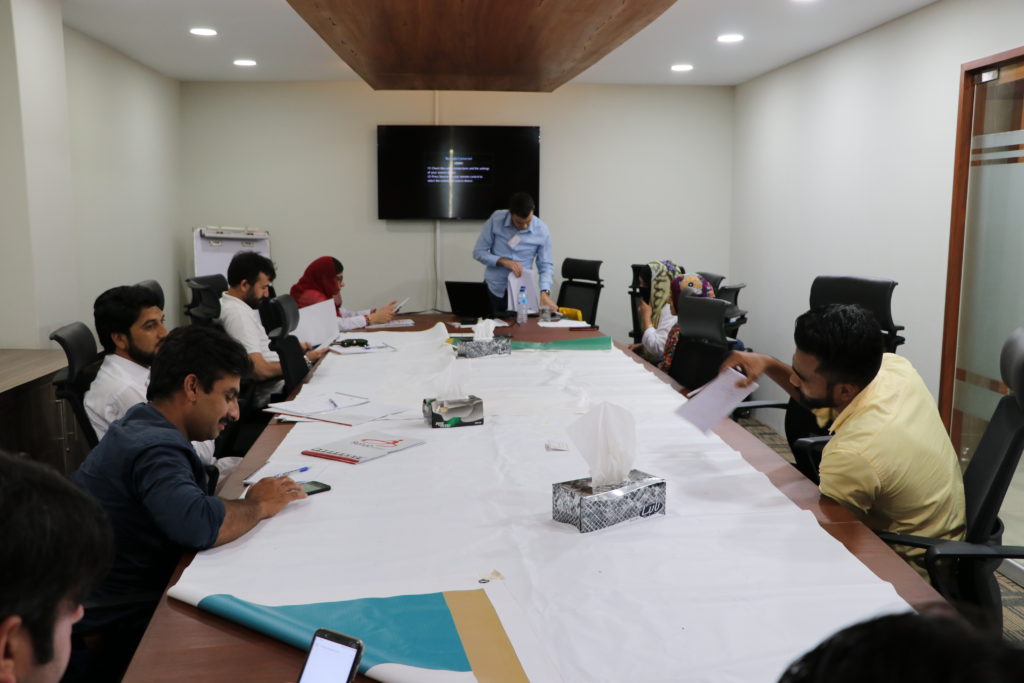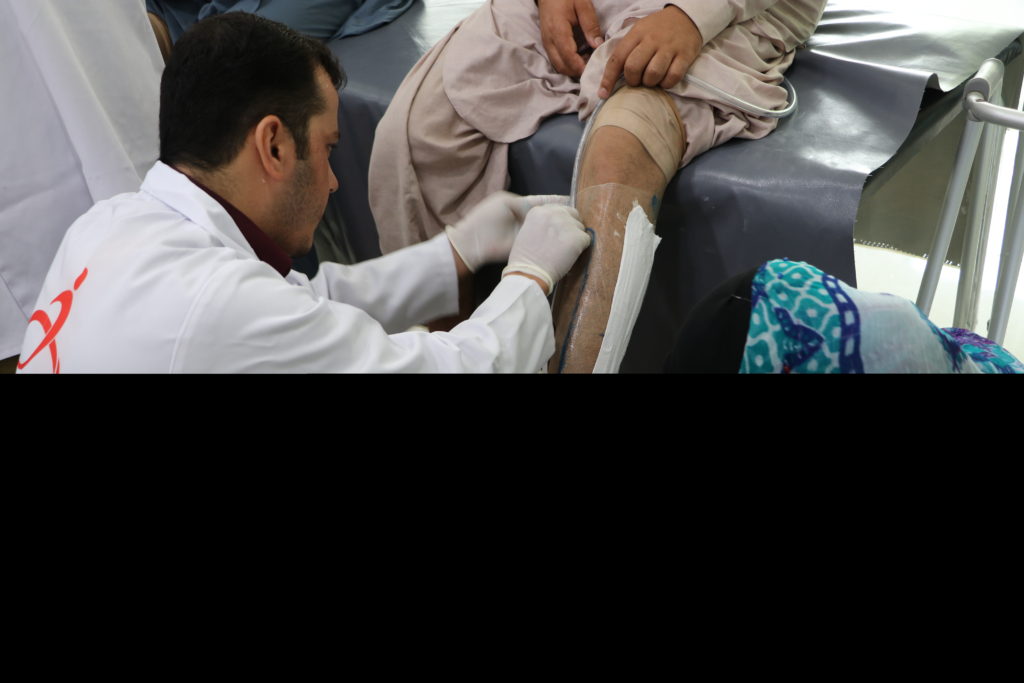On-site Clinical Instructions and Training on Partial Foot Prosthesis

Global statistics suggest that over 15% of the people in the world suffer from one or other forms of disabilities. Among these roughly one billion of the global population, the people with physical disabilities form a major chunk of the disability demographics due to trauma and diseases. With an increasing number of amputations, existing literature reports partial foot amputations as one of the most commonly prevailing amputations of the lower limb.
A patient having a partial foot amputation has their foot amputated below the ankle. The degree at which the amputation occurs may vary according to the different levels of the amputation. The major causes behind a partial foot amputation are mainly road traffic accidents (RTA), trauma(crush injuries, mine explosion, gunshot & burn etc) and disease (diabetes & gangrene etc)

A partial foot prosthesis is a prosthetic device to replace the lost part of the foot providing maximum comfort and mobility. There is a wide range of partial foot prosthetic options from a simple toe filler to a high profile device that goes up to the knee depending on the level of the amputation and weight-bearing capacity of residual limb). Sometimes amputation is performed through the ankle, or through the bones called the tarsals and meta-tarsals or sometimes just a portion of their toes is missing. Depending on the level of amputation, ortho-prosthetists fabricate assistive appliances to assist in regaining maximum mobility.

To make the rehabilitation of persons with physical rehabilitation ever more accessible to persons in need, the Rehab Initiative in collaboration with the ICRC and the Human Study (Germany) promotes the capacity building of the P&O personnel in the field of physical rehabilitation. To make prevalent the provision of high-quality services, the RI and ICRC organized a specialized module course on partial foot prosthesis for P&Os from different physical rehabilitation centers across Pakistan.
Like all other specialized courses in prosthetics and orthotics conducted at the RI facility, this module was conducted to train P&Os to update their knowledge and skills in the partial foot prosthetics. The first six weeks period consisted of weekly online sessions for all the participating P&Os, where they were not only given access to theoretical material, quizzes and reference manuals on partial foot prosthesis (PFP) but also weekly online interactive lectures by designated trainers. The online learning session included all the aspects of partial foot amputation, the associated causes, and pathologies prior to diagnosis. Coupled with weekly quizzes, the online lectures also covered subjects such as anatomy, biomechanics of a partially amputated foot versus that of a normal person, muscle grading, along with all the specific techniques used by surgeons to perform amputations and the relevant designs of prostheses corresponding to the levels of amputations.

After completion of the online session, the trainers of this course made a week-long visit to the Rehab Initiative training lab to put the accumulated skills and learning to practical use for device fabrication. Day one consisted of the revision of the theory taught to the P&Os over the course of the online learning period. The first day was consumed by interactive question answering sessions between the participants and their trainers. An in-detail revision was done, to sum up, all the weeks of online learning.
Once the P&Os were done with all the revision of the course, the trainers commenced with a practical demonstration of all the steps involved in the fabrication of PFP – from clinical assessment to the final fabrication and fitting of the device. In this step, the patients were examined in detail for muscle balance, muscle strength, any scars due to surgery and the overall condition of the residual limb. Along with checking sensation levels throughout the residual limb, the trainers identified all the pressure areas and the relevant designs that can be fabricated according to the condition of the stump.

On the basis of the assessment, the trainers diagnosed the exact level of PF amputation and prescribed the prosthetic device to replace the lost part of the foot and its function. The participants also followed the same procedures for assessment as demonstrated by the P&O trainers. With the initial assessment of their respective patients, all participants had conducted measurements of the patient’s residual limb and prescribed the device according to the level, type and complexities of their amputation.
In this training, different grades of prostheses were prescribed to different levels/type of amputation. A few patients also required high profile prosthesis to compensate for a significant portion of the foot and function lost due to amputation.

The P&Os then took negative casts of their patients by draping plaster of Paris bandages dipped in water onto the patient’s affected area. These bandages are then massaged according to the shape of the stump, which captures all the bony contours of the stump to replicate the exact shape. After removing the negative casts, the P&Os then filled the casts with a mixture which upon drying takes the exact shape of the stump.

Upon removal of the negative cast, the P&Os proceeded towards modifying the positive model to create an exact impression of the patient’s stump. Modification is done by using buffing and reinforcing techniques to add all the dips and curves in the patients’ stump.
The steps involved in the fabrication of a partial foot prosthesis vary according to the type of prosthesis prescribed. In the case of a Syme amputation which runs through the ankle of the patient, a soft in-liner is fabricated by making a conical shape of an EVA foam. This cone is then heated and draped on to the POP model of the stump.

Suction aids the liner in taking the exact shape of the stump. To achieve a sound side-like area of weight distribution of the foot, additional layers of EVA are added to the model to achieve the desired thickness of the foot, trimming off the excess material to create a foot-like appearance. Uneven edges are then buffed out using a router machine. The day 5th of the training concluded with all the P&Os fabricating their soft in-liners for their models.

The next day the P&Os fabricated sockets for their prostheses. This training course stood out among all others because of the following three different fabrication methods which were all used in the training:
Molding with Polypropylene sheets:
Molding is done on the model using PP sheets which are heated to make them pliable. While the polymer sheets are heated, the model of the prosthesis is connected to a suction machine. Once the sheet is heated to the desired temperature, they are carefully draped on to the model taking shape of the model with precision provided by the suction. A seam is created at the lower end and the excess PP sheet is trimmed off. A few P&Os fabricated their sockets using this technique.

Lamination:
Lamination is done by strengthening different fabric layers with polyester resin. This is achieved by applying PVA sheet on the positive model and then putting on the required amount of stockinette of different fabrics such as nylon, perlon, cotton, fiberglass and carbon fiber, etc. A lamination material mixture is achieved by combining polyester resin with specific quantities of two chemicals which act as a hardener and an accelerator. The pigment is added to this resin to add color to the socket.

A PVA foil is fabricated by the P&Os which is a cone-like layer of PVA material. This is applied on to the model, where it acts as an outer covering and container for the lamination resin. This assembly is attached to a suction machine to aid in the movement of resin along with the model. Once the resin is ready, it is poured on the model. Ortho-prosthetists manually push the lamination material along the length of the model. The suction, on the other hand, ensures that no air remains in the lamination material, achieving a perfect socket. This socket is then set aside to allow the material to settle down.

Lamination with carbon fiber sheets
To provide additional strength to the prosthesis, some ortho-prosthetists replaced a couple of stockinettes with a layer of carbon fiber sheet during lamination. Layers of carbon fiber are wrapped on to the model before pouring the resin material. Now when this socket is ready, it is more durable and lighter due to its chemical properties & composite of the carbon fiber.

The positive POP model is then removed from the socket. The socket is then finished using a router machine to buff out any sharp edges or lines. The patients come in for the fitting of the prosthesis. The initial fitting requires them to try their prosthesis for the first time.
The patients practice gait during this initial fitting for the first time. After subjective feedback from the patients, changes are made by the P&Os to achieve maximum comfort of the patient and achieve the desired length of their prosthesis.
Patients who have never worn a prosthesis prior to this usually take longer than other patients to adjust with their new prosthesis. During regular follow up sessions, patients can practice their gait to achieve close to normal walk.

Upon completion of the device fabrication, the P&Os under supervision of their trainers successfully checked the patients out. The trainers were content on the performance of their students. The second last day ended with positive feedback from both the patients and the trainers.

The last day of the training usually consists of the online exam, which assesses the P&Os on the basis of the theory learned over the period of online theoretical lectures. The e-exam of partial foot prosthesis lasted for 2 hours under the online and onsite supervision of Human study and RI staff which brought the module to an end. These courses not only help in expanding pools of knowledge but also help build a network of professional learning that in the long run will help promote the dissemination of updated knowledge throughout the P&O society in Pakistan.
